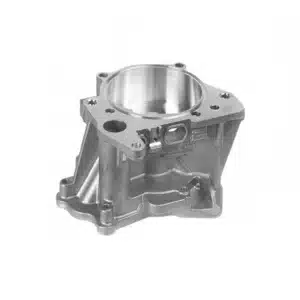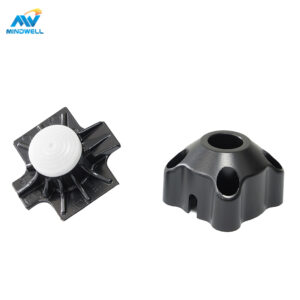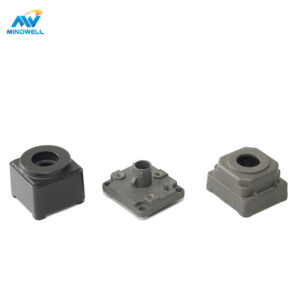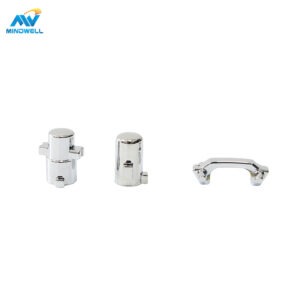At Mindwell, we offer Aluminium-Druckgusserzeugnisse with precision, efficiency and versatility. Our company is experienced in all aspects of the aluminum die casting manufacturing process, and we produce aluminum pressure die casting products for a wide range of industries.
Aluminum die casting is a manufacturing process that produces complex, high-quality parts with superior precision, and whether it’s in the automotive industry, aerospace applications, or consumer electronics, the versatility of aluminum die casting offers many options for the production of complex components.
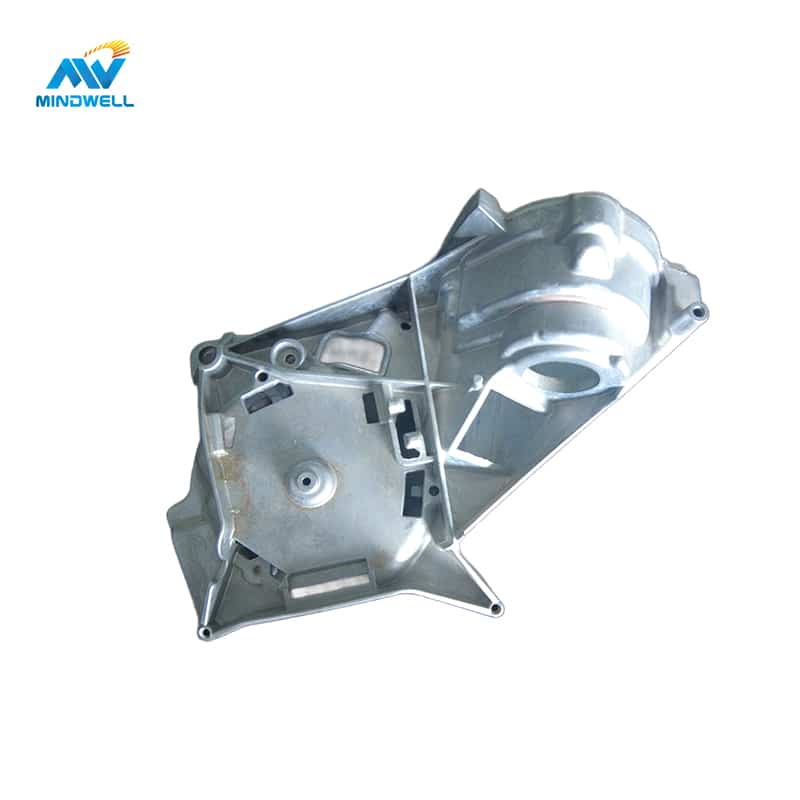
1. Advantages of aluminum die casting
The advantages of using aluminum die-cast products are many. First of all, not only can it create complex designs, but its production costs are relatively low compared to other manufacturing methods, which can save a lot of costs. Secondly, the aluminum die-casting process is very efficient and can produce the required die-casting parts in batches. Finally, coupled with their ability to produce parts with minimal post-processing, aluminum pressure die-cast products are an excellent choice for part manufacturing.
2. Materials used in aluminum die casting
Aluminum die casting is a process of manufacturing parts by using a mold and pressure to force molten aluminum material into a mold. In the Mindwell workshop, the most common material we use is aluminum alloy, and the choice of aluminum alloy directly affects the characteristics of die-cast parts, such as strength, heat resistance, durability, etc.
The following are several aluminum alloy materials commonly used in aluminum die casting:
- ADC12 (Japan): This is a high-silicon aluminum alloy with excellent fluidity, filling and shrinkage properties. It has high strength, good wear resistance and good processability. Therefore, ADC12 is widely used in the manufacturing of die-cast parts in the fields of automobiles, electrical appliances, and mechanical equipment.
- A380 (USA): A380 is a high-strength aluminum alloy with excellent wear resistance and fatigue resistance. It has a wide range of applications and is suitable for manufacturing automobiles, aircraft, mechanical parts, etc.
- ZL108 (China): ZL108 is an aluminum alloy with a high silicon content and excellent wear resistance and fatigue resistance. At the same time, it also has excellent casting and machining properties, so it is often used to manufacture die-cast parts in automobiles, tractors and other fields.
- AlSi12 (Europe): AlSi12 is a high-strength aluminum alloy with excellent wear resistance and fatigue resistance. It has a wide range of applications and is suitable for manufacturing automobiles, aircraft, mechanical parts, etc.
- AlMg5 (China): AlMg5 is a magnesium-aluminum alloy with high strength and good corrosion resistance. It has a wide range of applications and is suitable for manufacturing automobiles, aircraft, mechanical parts, etc.
- Each of these aluminum alloy materials has its own advantages and scope of application. Which material to choose mainly depends on the characteristics and application scenarios of the required parts. For example, ADC12 and A380 are suitable for parts that require high strength and wear resistance; ZL108 is suitable for parts that require high wear resistance and fatigue resistance; AlSi12 is suitable for parts that require high strength and good wear resistance; and AlMg5 is suitable for parts that require high strength and good wear resistance. Parts with high strength and good corrosion resistance.
When selecting aluminum alloy materials, you also need to consider their melting point, shrinkage, tensile strength, yield strength and other physical properties as well as chemical composition. At the same time, corresponding process testing and verification are also required to ensure that the selected materials meet the requirements of the production process and product quality.

3. Applications in different industries
Aluminum die castings are widely used. From the Automobilbranche, which plays a key role in manufacturing engine components, to aerospace applications that require precision and reliability, and even in the production of consumer electronics and appliances, aluminum die castings are known for their lightweight, high strength, and good thermal conductivity. Due to its durability and ease of processing, it is widely used in various industries. The following are the applications of aluminum die castings in different industries:
Automobile industry:
- Engine parts: Aluminum die castings can be used to manufacture important components such as cylinder heads, cylinder heads, pistons, piston rings, and bearings for automobile engines. These parts need to withstand high temperatures and pressures, so the strength and heat resistance of aluminum die castings is critical.
- Chassis and suspension systems: Aluminum die castings can be used to manufacture components of automotive chassis and suspension systems, such as control arms, steering knuckles, etc. These components require high strength and corrosion resistance.
- Body structure: Aluminum die castings can be used to manufacture body structural parts, such as body panels, beams and columns, etc. These parts need to be lightweight and aesthetically pleasing.
Aerospace industry:
- Engine components: Aluminum die castings can be used to manufacture turbine blades, rotors and other components of aeroengines. These parts require high strength and high temperature resistance.
- Fuselage structure: Aluminum die castings can be used to manufacture fuselage structural parts, such as fuselage panels, beams and columns. These parts require lightweight and high strength.
- Other components: Aluminum die castings can also be used to manufacture other components in aerospace vehicles, such as fuel tanks, brackets, etc. These components need to be lightweight and corrosion-resistant.
Consumer Electronics and Appliances Industry:
- Housings and lids: Aluminum die castings can be used to manufacture housings and lids for consumer electronics and appliances, such as mobile phones, laptops, TVs, etc. These parts need to be lightweight and aesthetically pleasing.
- Internal structural parts: Aluminum die castings can be used to manufacture internal structural parts, such as brackets, radiators, etc. These components require high strength and good thermal conductivity.
other industry:
- Construction industry: Aluminum die castings can be used to manufacture building structural parts, such as curtain walls, roofs, etc. These parts require lightweight and high strength.
- Machinery and equipment industry: Aluminum die castings can be used to manufacture structural parts of machinery and equipment, such as machine tools, pumps, valves, etc. These components require high strength and corrosion resistance.
The aluminum pressure die-casting products we provide have a very wide range of applications, and different industries have different requirements for their characteristics and application scenarios. Therefore, when customizing aluminum pressure die-casting products, it is necessary to select appropriate aluminum alloy materials, mold design, production processes, etc. according to specific application scenarios to ensure that the quality and performance of the product meet the requirements.
4. Aluminum die-casting process
The die casting process involves several key steps. From the initial melting of the aluminum alloy to the injection of the molten metal into precision molds, control of temperature and pressure throughout the process ensures detailed and precise parts are produced. The following are the main steps of the aluminum die casting process:
- Melting aluminum alloy: When melting aluminum alloy, the temperature usually reaches 700-750℃. This step ensures that the aluminum alloy is completely melted and does not burn or oxidize.
- Pouring: When the temperature of the molten aluminum alloy reaches the required temperature, pour it into the die-casting mold cavity. The thickness and shape of the gate have a significant impact on the speed and pressure of filling the mold and require precise control.
- Filling the Mold: After pouring, the aluminum alloy fills the mold through the nozzles and gates of the die casting machine. The filling speed and pressure need to be controlled during this process to ensure that the aluminum alloy can evenly fill the entire mold.
- Cooling: After filling is complete, the mold will cool quickly and the aluminum alloy will solidify to form the die casting. Cooling rate has an important impact on the quality and performance of die castings and requires precise control.
- Demolding: When the die casting is completely cooled, the mold is opened and the die casting falls out of the mold. During this process, care must be taken to avoid the use of release agents from affecting the surface of the die casting.
- Processing and post-processing: After demoulding, die castings require further processing and post-processing, such as cutting, polishing, spraying, etc., to meet the requirements of the final product.
In the aluminum die-casting process, each step requires precise control to ensure the quality and performance of the final product meet requirements. In addition, in order to improve production efficiency and reduce costs, the entire production process also needs to be optimized, such as selecting appropriate mold materials and designs, optimizing pouring systems, adopting automation and robotics technology, etc.
At MIndwell, when our company customizes aluminum pressure die-casting products for you, we carry out detailed design and planning based on specific product requirements and production conditions as needed.

5. Quality Assurance and Testing
Ensuring the quality and reliability of aluminum die-cast products is crucial. Our company employs stringent inspection and testing methods to identify any flaws or defects and ensure that the final product meets the required standards. The following are the quality assurance and testing methods commonly used by our company:
- Raw material inspection: Strict quality inspection is carried out on aluminum alloy materials used for die-casting to ensure that they meet specifications and requirements.
- Mold inspection: Regularly inspect and maintain the die-casting mold to ensure that it is in good condition, has high precision, and can produce die-casting parts that meet quality requirements.
- Process control: By using advanced die-casting technology and equipment, we control factors such as temperature, pressure, and time during the die-casting process to ensure the quality and reliability of die-casting parts.
- Dimensional inspection: Dimensional inspection of die-casting parts, including appearance dimensions and internal dimensions, is necessary to ensure that they meet design requirements and customer standards.
- Metallographic analysis: Through the metallographic analysis method, the microstructure of the die casting material is observed and analyzed to evaluate its mechanical properties and corrosion resistance.
- Non-destructive testing: Use non-destructive testing technology, such as ultrasonic testing, radiographic testing, etc., to detect internal defects in die-casting parts to ensure their quality and reliability.
- Reliability test: According to the requirements of product application, reliability tests are conducted on die castings, such as durability test, environmental adaptability test, etc., to ensure that they can work stably under different conditions.
- Quality management system: Adopt internationally recognized quality management systems, such as ISO 9001, to comprehensively monitor and manage the production process to ensure the consistency and reliability of product quality.
By adopting these quality assurance and testing methods, potential defects and problems can be effectively identified and eliminated, ensuring the quality and reliability of aluminum die-casting products. At the same time, it can also improve production efficiency, reduce costs, and deliver high-quality precision aluminum die-casting parts to you.
6. Environmental considerations
While aluminum die casting can increase production efficiency, its impact on the environment must be considered. Our company takes the following steps to make aluminum die casting manufacturing more sustainable and environmentally friendly:
- Material selection: Choose environmentally friendly aluminum alloy materials, such as recyclable aluminum alloy, to reduce the consumption of natural resources. At the same time, reduce the use of alloys containing harmful substances.
- Energy efficiency: optimize die-casting processes and equipment, improve energy utilization efficiency, and reduce energy consumption. For example, using advanced insulation technology, optimizing mold design and cooling system, etc.
- Waste treatment: classify and treat waste generated during the production process. For example, recycling scrap aluminum and scrap materials can reduce the impact of waste on the environment.
- Reduce emissions: Optimize the smelting and pouring processes to reduce emissions of harmful substances. For example, environmentally friendly melting furnaces and pouring systems are used to reduce the generation of waste gas and waste slag.
- Water resources management: make rational use of water resources and reduce the waste of water resources. For example, use water-saving equipment and processes to treat and reuse wastewater.
- Packaging and transportation: Optimize packaging and transportation methods to reduce environmental impact. For example, use environmentally friendly packaging materials and transportation methods to reduce the impact on the environment.
- Life cycle assessment: Assess the life cycle of aluminum die-casting products, including raw material extraction, production, use, recycling and reuse, to comprehensively assess its impact on the environment.
- Education and training: Strengthen employees’ environmental awareness and training, improve employees’ environmental awareness and skill levels, and promote the construction of corporate environmental culture.
By taking the above measures, Mindwell can not only protect the environment but also bring long-term economic and social benefits to the company.
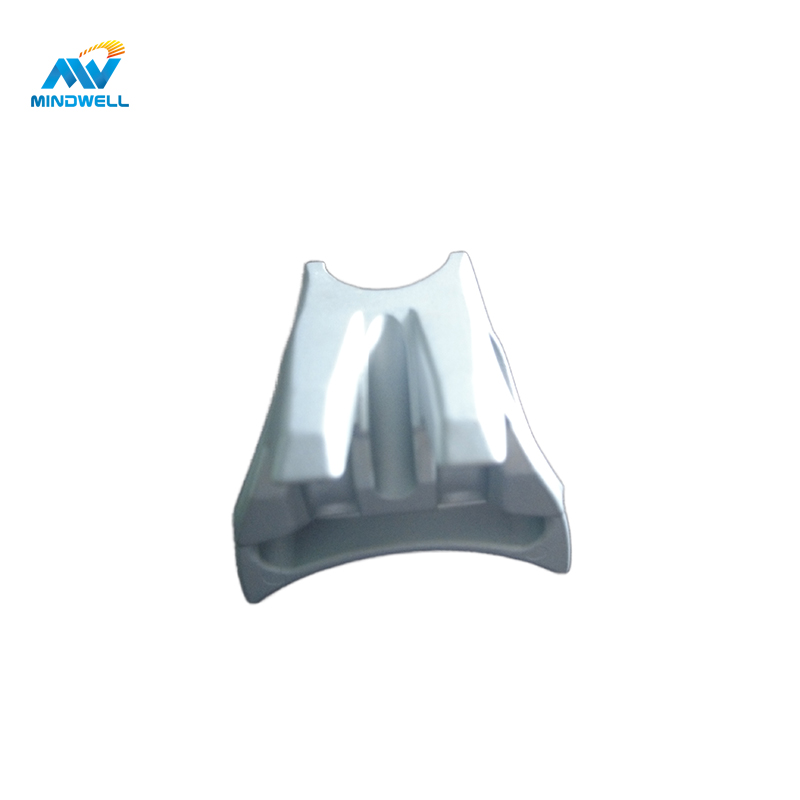
7. Conclusion
In summary, aluminum die casting is the cornerstone of modern manufacturing, offering precision, efficiency and versatility. Aluminum die castings are capable of manufacturing complex components with extremely high precision, making them a key player in various industries. If you have ideas for custom aluminum pressure die casting products, please contact us directly. We will give you a satisfactory solution.





